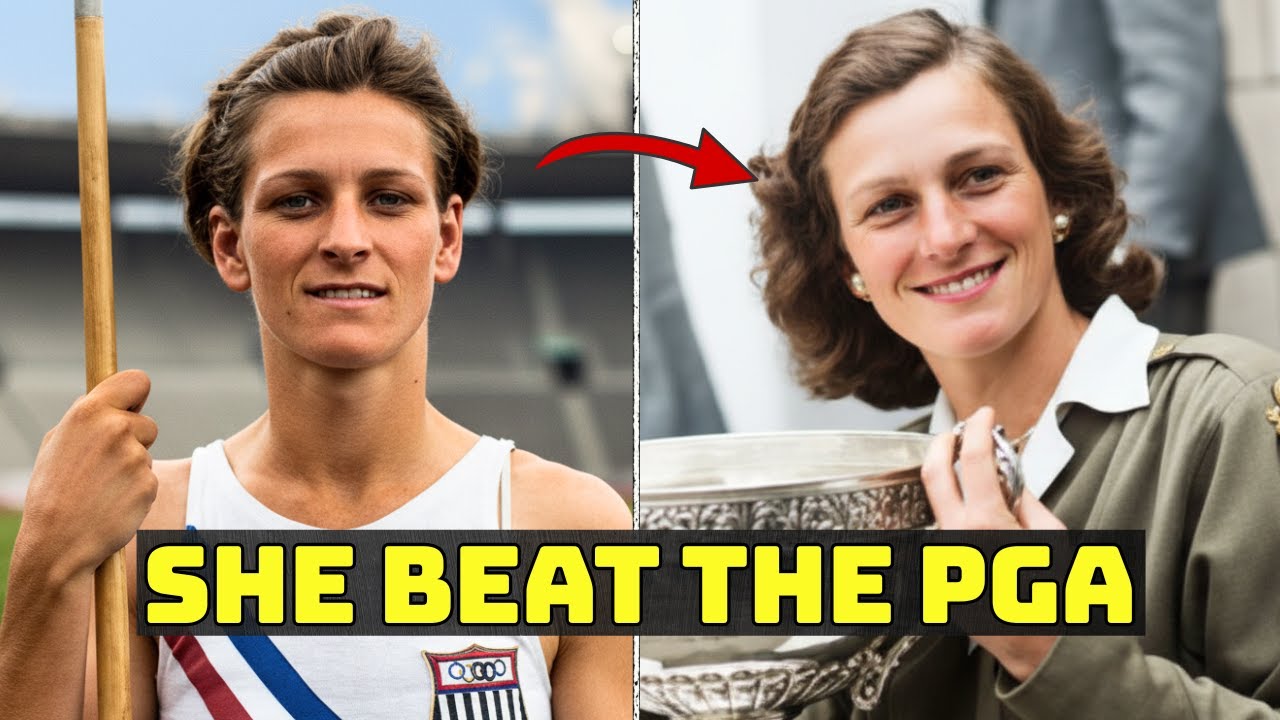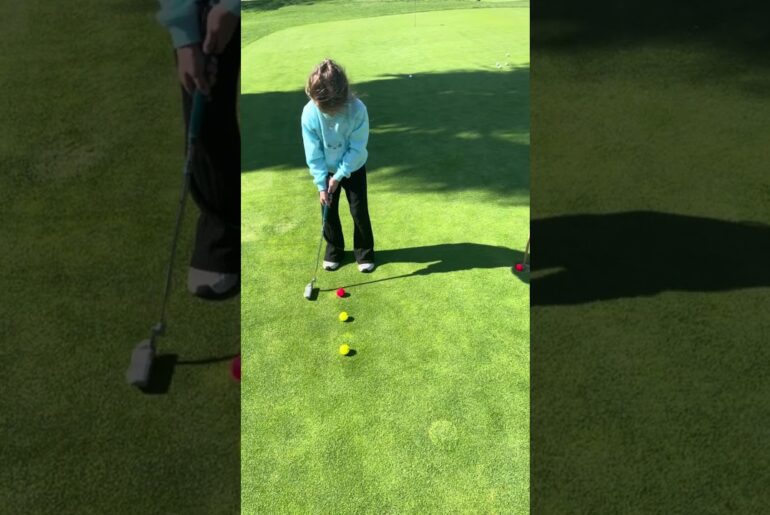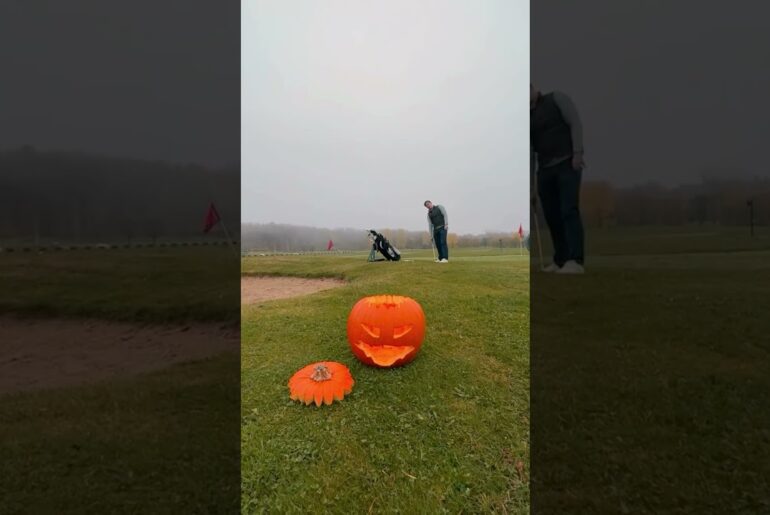She Didn’t Join The LPGA — She Created It
Babe Didrikson Zaharias wasn’t just a champion — she was a force that changed golf forever. From breaking into the PGA to founding the LPGA and conquering impossible odds, Babe Didrikson Zaharias proved that talent knows no boundaries. This is the story of how Babe Didrikson Zaharias redrew the lines of an entire sport.
#golfers #golferslife #BabeDidriksonZaharias
Copyright Disclaimers:
Our content is used in adherence to YouTube’s Fair Use guidelines. This may include copyrighted video clips and images used under U.S. Copyright Act Section 107 for commentary, news reporting, educational purposes, and more, without specific authorization from copyright holders.
is the apple of the gallery’s eye as she turns in a fine performance. Every sport draws a line, a mark that divides who belongs and who does not, who advances and who fades away. Most players spend their lives staying on the safe side of that line. But a few look at it, measure it, and decide to cross. In golf, that line once seemed unshakable. It separated men from women, professionals from amateurs, and the possible from the impossible. Then came a woman who refused to be contained by any of it. Her name was Babe Dedrickson Zaharas. She was not supposed to compete against men. She was not supposed to win majors after surgery. She was not supposed to build a league that would outlive her. Yet she did all of it, not with protest, but with performance. Each swing, each round, each victory redrrew what golf thought it already knew. This is not only the story of a champion. It is the story of a woman who forced golf to redraw its boundaries. One drive, one cut line, one impossible comeback at a time. If you enjoyed this opening, please like and subscribe. To understand how Babe Dedrickson Zaharas forced golf to redraw its boundaries, we must begin with what she actually did. Not as myth, but as fact. In the middle of the 1940s, the world of professional golf was divided by gender and guarded by tradition. No woman had ever stepped into a men’s professional tournament and survived the cutline, the score that determined who would continue after the early rounds. Babe did not ask for an invitation. She entered through the same qualifying process as every man in the field. She played her way in and then she played well enough to stay. That single act, passing the cutline in a PGA event, rearranged the map of what golf believed was possible. Yet, she did not stop there. When she helped to found the LPGA, she was not creating a separate corner for women. She was creating a structure, a stage, and a future. The league gave women their own tour, their own schedule, and the credibility they had long been denied. And later, when illness threatened to end her career, she returned to win a major championship by a wide margin. That victory was not only about recovery, it was about expanding the limits of endurance itself. Taken together, her entry into the men’s tour, her founding of the LPGA, and her comeback win. These moments are the proof of the title you are hearing now. Babe Dedricson Zaharas did not follow golf’s rules of belonging. She remade them. Confidence came to Babe Dedrickson Zaharas early and it never left her. She carried herself as if the game, whatever game it was, existed to test her limits. Her stride was fast, her gaze direct, her humor quick and sharp. When people told her what women could or could not do in sport, she answered with performance rather than argument. She once walked into a field of competitors and said, “Who’s coming in second?” It sounded arrogant, but it was simply how she translated certainty into motion. That certainty became the engine of her transformation from a gifted athlete into one of golf’s greats. She did not treat golf as a polite pastime. She treated it as a proving ground. Every shot was an assertion that she belonged wherever talent could reach. In an era when modesty was expected of women, Babes’s directness unsettled some and inspired others. She laughed loudly, dressed simply, and talk straight. Crowds came not only to watch her skill, but to feel her energy, that sense of boldness wrapped in grace. Her confidence was not rebellion for its own sake. It was strategy. It drew attention. It built pressure. And under that pressure, she thrived. Her swagger was never empty. It had purpose to redefine what a woman athlete could sound like, look like, and ultimately achieve. Before Babe Dedricson Zaharayas became a legend in professional golf, she mastered something far more difficult than a perfect swing, the art of finishing. In competitive golf, there are two main forms of play. Match play means facing one opponent directly hole by hole, while stroke play counts every shot across the entire round. Babe learned to command both. She knew when to attack and when to steady her rhythm, reading not only the course, but the people sharing it with her. Her amateur years were a relentless education and control under pressure. She entered tournaments with the same hunger she had carried from her youth and learned that victory often depends less on brilliance and more on endurance. When others faltered in the final holes, she sharpened her focus. When nerves stole precision from seasoned players, she seemed to breathe slower and aim straighter. Winning became a habit, not by luck, but by discipline. She studied her own mistakes with an honesty that few champions allow themselves. Each setback was a classroom. Each narrow escape another rehearsal for the calm she would need later on the grandest stages. By the time Babe turned professional, she already understood what many never learn. Talent opens the door, but the ability to close it under pressure, fatigue, and doubt is what builds greatness. By the late 1940s, women’s golf existed in scattered events and local exhibitions, but there was no unified tour. no shared platform and little respect from the institutions that govern the game. Babe Dedrickson Zaharayas saw that gap not as a barrier but as an unfinished opportunity. Together with a small group of equally determined players, she helped establish what would become the Ladies Professional Golf Association, the LPGA. The goal was not separation for its own sake, but creation of a stage where talent could be measured on its own terms. They wrote schedules, negotiated venues, and built a system of competition that demanded the same standards of professionalism as the men’s tour. In every meeting, Babe’s voice carried a rare blend of authority and humor. The tone of someone who expected equality, not as a favor, but as fairness. Through her leadership, the LPGA was born from persistence rather than privilege. It gave young players something Babe herself had never been offered. a visible path, a professional future, and a league that belonged to them. What began as a handful of women organizing their own tournaments became a foundation that changed the landscape of modern golf. For Babe, founding the LPGA was not just administration. It was legacy in motion. It ensured that the next generation would not have to ask permission to compete. They would simply show up and play. Babe Dedricson Zaharayas played golf with a rare combination of strength and stillness. Her power was not brute force, but rhythm, an unbroken sequence from stance to follow-through. Off the tea, her drives flew long and straight, a mix of precision and audacity that startled even seasoned professionals. When she swung, the motion looked effortless, yet the ball carried far beyond expectation. Her nerve showed most clearly in moments when others tightened. Under tournament pressure, she held her posture, trusted her tempo, and let instinct do what fear often interrupts. Observers noted that her expression never changed after a miss or a perfect shot. She treated both as part of the same lesson. That calm did not come naturally. It was practiced, the product of countless hours alone on a driving range, repeating the same sequence until confidence became muscle memory. Clarity defined her decisions on the course. She calculated risk without hesitation, choosing bold lines toward the green that match her temperament. When she puted, she focused only on the roll and the sound of the ball falling into the cup. In her hands, golf looked simpler than it truly was. This balance of power, nerve, and clarity transformed her from a talented athlete into one of golf’s great. She did not just play the game. She revealed what complete composure under pressure could look like. In 1945, the world of golf still belonged entirely to men. Tournaments on the PGA Tour were guarded by rules and custom that no woman had ever tested. Babe Dedricson Zaharas decided to test them all at once. She entered the men’s events the same way every other competitor did by qualifying. There were no invitations, no exemptions, only the quiet conviction that her game would be enough. The cut line in golf marks the score required to stay in a tournament after the opening rounds. It is a boundary that divides contenders from the eliminated. Babe crossed it. Her drives match the men’s in distance. Her short game held under pressure and her total score placed her above the line that had defined professional golf for decades. No woman before or since has repeated that feat. Crowds at the time were unsure how to react. Some cheered in disbelief. Others whispered that it must be a fluke. But Babe understood the deeper meaning. The moment her name appeared above that dividing line, the conversation about women’s ability in golf changed forever. She had not only competed, she had endured. Measured by the same standard as every man in the field. That week on the PGA Tour, she did more than survive a tournament. She altered the idea of who was allowed to stand on that course. The cutline became something new, a symbol of possibility. Greatness often meets its sharpest test when the body begins to fail. For Babe Dedricson Zaharas, that moment arrived after years of dominance. The same drive that had carried her across fairways now had to confront limits that no training could erase. Illness struck unexpectedly, forcing her to step away from the sport that had defined her life. Recovery demanded a different kind of strength. Each day became an exercise in patience rather than power. The competition she once found on the course turned inward against fatigue and pain. Yet, even in the quiet of recovery, Bab’s determination did not dim. She studied the rhythm of healing as carefully as she once studied her swing, counting small gains instead of trophies. Friends and doctors advised rest. But rest was never her language. She replaced ambition for victory with ambition for movement, one more walk, one more practice stroke, one more chance to feel the weight of a club in her hands. Her comeback was not built on hope alone, but on the same discipline that had always guided her career. Between will and body, Babe found a balance strong enough to return her to the game. And when she stepped onto the tea again, she carried with her something even rarer than skill, the proof that resilience itself can be a form of genius. When Babe Dedrickson Zaharas returned to competition, the world watched with cautious curiosity. Many doubted that a body once weakened by illness could again command the precision and force needed to win. But Babe did not return to be admired for courage alone. She returned to compete. At the US Women’s Open 1954, she walked the course with the same composure that had once carried her through the men’s fields. The fairways were long, the greens unforgiving, yet her rhythm was steady from the first te to the final hole. Each drive sounded like a declaration that she was not done. Each putt a quiet reminder that champions decide when their story ends. She won that championship by a margin so wide it felt symbolic. A statement not of dominance over others, but of mastery over adversity. The crowd that followed her down the final fairway did not see only a golfer. They saw a human being who had measured suffering and turned it into focus. In that victory, Babe transcended competition itself. She had crossed a different kind of line, the boundary between endurance and transformation. Her triumph was not just a return. It was a revelation that greatness once earned can survive even the darkest interruption. Babe Dedrickson Zahareas never measured success only by the trophies lined up on her shelf. For her, the game was also about connection, the invisible thread between player and audience, between effort and inspiration. After her greatest victories, she often spent time giving clinics, teaching young players not just how to swing, but how to think like competitors. She spoke plainly without pretense, showing that mastery was built from patience more than talent. Spectators who came to see her play rarely left untouched. She laughed easily with the crowds, sometimes joking with the caddies or children who watched from the rough. Her presence filled a course long before she took a swing. Even opponents who had lost to her admitted that she carried a kind of generosity uncommon in fierce competition. She wanted to win, but she also wanted everyone around her to love the game as much as she did. As her influence grew, she used her platform to champion women’s participation in sports. She appeared in exhibitions and charity events that brought visibility and funding to causes far beyond golf. In every gesture, Babe reminded the world that greatness is not only about how far a ball can travel, but how wide an impact a single life can make. By the time Babe Dedrickson Zaharas reached the final years of her career, she had already transformed golf into something larger than its traditions. What began as one woman’s determination had become a movement of redefinition. The sport that once drew its boundaries so clearly between men and women, amateurs, and professionals, limits and possibilities, was now marked by her footprints on both sides of the line. Through the LPGA, she helped build an institution that stood as proof that skill has no gender. Her founding vision created a league that continues to shape modern golf, giving countless players a path she once had to carve alone. Every tournament they play, every paycheck they earn, and every audience they reach carries traces of the system she imagined. Her story also altered the culture of competition. She showed that excellence does not need approval to exist. It creates its own legitimacy. Her victories against expectation, her calm in adversity, and her refusal to let convention define her remain lessons for every athlete who has ever been told to stay within boundaries. Today, when historians call her one of golf’s greats, it is not only because of what she won. It is because she permanently changed the map of where greatness could be found. The story of Babe Dedricson Zaharas is no longer confined to memory or archives. It lives in every young athlete who steps onto a course believing there are no fixed limits. The line that once divided who could compete and who could not still exists in many forms, but because of her, it no longer feels permanent. She taught that boundaries are drawn by convention, not by capacity. Her life became a lesson in persistence, in showing up even when the odds were unreasonable, and in winning respect through mastery rather than words. She proved that the truest victories are not only recorded on scorecards but written into the collective imagination of a sport. To speak her name today is to recall more than the swing or the trophies. It is to remember courage disguised as routine, brilliance performed without complaint and leadership that reshaped an entire discipline. She stood at every kind of line, professional, social and personal and turned each one into a starting point. That is what the line means now. It is not a limit but an invitation. And the next time the world decides where it should be drawn, it will have to remember the woman who crossed it first. If you enjoyed this story, don’t forget to subscribe and check out other similar videos on the channel. Your support means a lot to our team. Thank you.








1 Comment
It helps if the narrator can actually pronounce the subject's name properly.